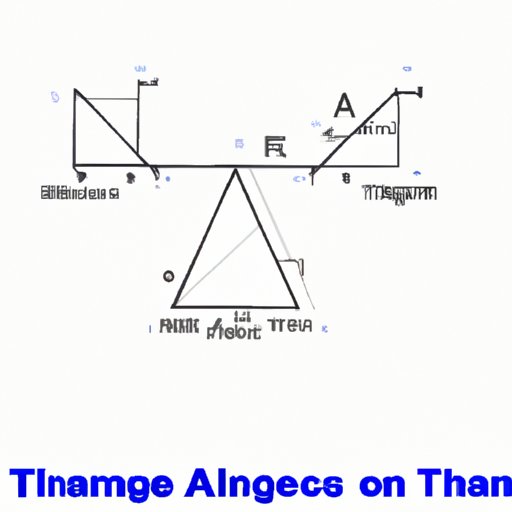
Introduction
Have you ever wondered how to calculate the area of a triangle? Whether you are a student, a professional, or just someone who enjoys learning new things, knowing how to calculate the area of a triangle can be useful in many real-life scenarios. This comprehensive guide will take you through the steps of calculating the area of a triangle, provide real-world examples, and offer fun interactive activities to help you gain a better understanding of this concept.
Step-by-Step Guide
The formula for calculating the area of a triangle is simple: Area = 1/2 x Base x Height. To calculate the area of a triangle, first, find the base and height of the triangle. The base is the bottom of the triangle, and the height is the perpendicular line from the base to the top point of the triangle.
To apply the formula to different types of triangles, let’s look at some examples:
Example 1: Equilateral Triangle
An equilateral triangle has all three sides and angles equal.

To find the area of an equilateral triangle, use the formula:
Area = (Root 3 / 4) x (Side)^2
For example, if the side of the equilateral triangle is 4cm:
Area = (Root 3 / 4) x (4)^2
Area = 4Root 3 cm^2
Example 2: Isosceles Triangle
An isosceles triangle has two equal sides and two equal angles.

To find the area of an isosceles triangle, use the formula:
Area = (Base x Height) / 2
For example, if the base is 10cm and the height is 5cm:
Area = (10 x 5) / 2
Area = 25 cm^2
Example 3: Scalene Triangle
A scalene triangle has three different sides and angles.

To find the area of a scalene triangle, use the formula:
Area = (Base x Height) / 2
For example, if the base is 6cm and the height is 3cm:
Area = (6 x 3) / 2
Area = 9 cm^2
Real-World Applications
The area of a triangle is a commonly used concept in many fields such as architecture, construction, and engineering. In architecture, the area of a triangle can help calculate the material needed to build roofs, floors, and walls. In construction, it can help with finding the amount of concrete used, while in engineering, it can help calculate the amount of force or pressure acting on a structure.
Knowing how to calculate the area of a triangle can help professionals in these fields make their work more efficient and accurate.
Interactive Quiz
To test your knowledge, let’s participate in a multiple-choice quiz on calculating the area of a triangle. Fill in the blanks and answer visual examples
Question 1:
The area of a triangle is calculated as:
- (Base + Height) / 2
- Base x Height
- 1/2 x Base x Height
- Base x 2
Answer: 3
Question 2:
What is the formula to find the area of an equilateral triangle?
- Area = (Base x Height) / 2
- Area = Side^2
- Area = (Root 3 / 4) x (Side)^2
- Area = Base x 2
Answer: 3
Question 3:
What is the area of the following triangle?

- 15 cm^2
- 25 cm^2
- 30 cm^2
- 35cm^2
Answer: 2
Comparing Different Methods
Although we have seen the formula to calculate the area of a triangle, there are other methods as well, such as Heron’s Formula and trigonometry.
Heron’s Formula is useful when the length of the sides of the triangle are known. Given that the triangle’s sides A, B, and C are known, Heron’s Formula states that:
Area = Root(s(s-A)(s-B)(s-C))
where s is half the triangle’s perimeter (i.e., s = (A + B + C) / 2). One advantage of using Heron’s Formula is that knowing only the lengths of the sides is enough to calculate the area.
In trigonometry, the area of a triangle can also be calculated using the formula:
Area = 1/2 x (Side 1) x (Side 2) x Sin(Angle between Sides)
Although these methods exist, the formula Area = 1/2 x Base x Height is considered the most straightforward and practical.
Fun Activities
If you want to test your skills on a real-life scenario, grab a ruler and a protractor. Measure the length of the base and the height of an object near you that has the shape of a triangle, such as a flag or a poster. Calculate the area of this object.
Conclusion
Calculating the area of a triangle is an essential concept in mathematics. Through this article, we have learned how to calculate the area of a triangle by using different formulas, explored real-life applications, participated in an interactive quiz, and seen how different methods compare. By practicing the formula regularly, you can become more efficient and confident when dealing with triangle structures in your daily life.




